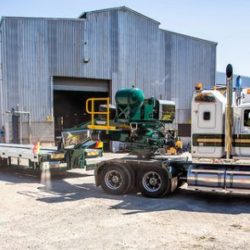Welcome to part two in our series on transport infrastructure reform. In part two we’ll dive into the top responses from the inquiry on the National Freight and Supply Chain Strategy.
What was called for by the strategy?
![]()
The National Freight and Supply Chain strategy should hopefully provide a roadmap for the heavy transport industry for the next few decades.
As it stands, there is no real overarching consideration and coordinated planning for the freight and oversize transport industry. The strategy has addressed this in earlier releases, saying there is a stronger need for integrated planning between federal, state and territory governments for “surface transport”.
So, the Department of Infrastructure and Regional Development led an inquiry. They called on Australian corporations, associations and individuals to help them determine how best to lift the productivity and efficiency of Australia’s freight and supply chain. More than 125 responses are currently being reviewed, with the final report to be released in March 2018.
The common talking points
![]()
Appropriate funding to support significant growth
Many believed that freight tasks need to be supported by appropriate changes in regulations so that roads, changeover centres, including rail and port facilities can improve productivity and reduce loses. It’s believed that there is enough money to support this, thanks to increasing in privatisation of these facilities, which government entities should be able to re-invest into new infrastructure.
Underestimating the growth of ecommerce
The Australian Logistics Council focused their submission around the grassroots freight requirements of everyday Australians, paying attention to the notion that government misjudges the growth of ecommerce businesses and personalisation for freights working in-line with ecommerce requirements.
Infrastructure investments over $100 million must be legislated
The ATA submission argues that current governance, taxation and institutional arrangements for the gathering and allocation of funds must be addressed. They believe that the current policy guiding infrastructure must be legislated.
Overcharging of the trucking industry
The ATA also advocates that the voices of the trucking industry must be heard by the National Freight and Supply Chain Strategy. They believe that Australia’s goal for global competitiveness will be at risk as long as trucking is overcharged.
“Overcharging simply builds additional costs into the supply chains – the economical, low-cost end-to-end supply chains that Australia’s global competitiveness relies on. Imposing unfair costs or failing to build and maintain our road network will leave Australian goods uncompetitive and unconnected from the global marketplace.”
On the other side of the coin, the Freight and Trade Alliance has said that the current charges are fair, appropriately applied, not excessive and not prohibitive to Australia’s economic growth.
Expectations for safety, security and environment
Australia is at a critical point in how we plan our freight and land transport networks. The National Heavy Vehicle Regulator (NHVR) emphasised the need for continued reform coupled with well-developed strategies that reduce red tape while optimising safety.
You’ve made it to the end of our two-part series on transport infrastructure reform. Keep your eyes peeled for the final report on the inquiry, which is set for release in March 2018.
The Drake Group are dedicated to improving productivity and safety for the freight industry with our general transport, oversize transport and heavy transport trailers. Whether you’re a heavy haulage company looking to transport front-loaders or a mining transport company looking for a custom-built trailer for your site, The Drake Group can help. Get in contact with us today.


